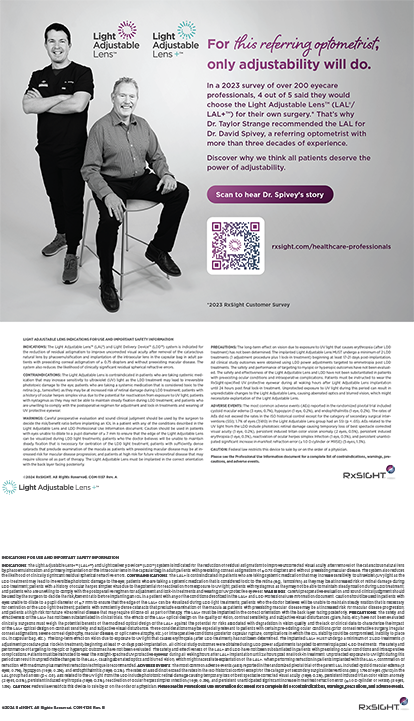Bausch & Lomb (Rochester, NY) recently doubled the speed of its Technolas 217z100 excimer laser. Like its 50-Hz predecessor, the new 100-Hz system is FDA approved for treating myopia with up to -7.00D of sphere and -3.00D of cylinder, with a maximum spherocylindrical equivalent of -7.50D, and hyperopia of up to 4.00D of sphere with up to 2.00D cylinder.
For the past 4 weeks, I have been using the Technolas 217z100 in my practice. This article describes my initial impressions and the outcomes of the procedures I have performed with this laser.
FASTER IS BETTER
My experience with the 100-Hz Technolas laser system has confirmed my expectation that it would produce more predictable and accurate results than its predecessor. My patients and I are impressed by the speed of the new laser. Now, it takes only 15 seconds to perform a typical -3.00D correction. At the end of surgery, my patients routinely ask, "Is that it?"
The shorter ablation time decreases how long the flap is exposed to the environment and thus reduces the risk of stromal drying and subsequent flap edema. The repositioned flaps fit well, and my patients can see immediately after surgery. The laser's speed and the quality of patients' immediate postoperative vision enhances the "wow" factor considerably.
In addition, patients no longer complain about the odor caused by laser ablation. Although the Technolas 217z100 probably produces the same amount of residue as its predecessor, the procedure is over before patients notice the smell.
MORE VERSATILE
Before the company introduced the 100-Hz laser, improvements to the Zyoptix platform shortened treatment time by reducing the number of phases in a given ablation. Recent upgrades, such as the new bilateral treatment mode and the multiuse treatment card, streamline the preoperative workup and procedural times by as much as 30.
The new Zyoptix system lets me modulate the time between laser pulses and adapt each treatment to current environmental conditions. For example, high humidity increases the chances of undercorrection. When I operate on hot, humid days (which are not uncommon in South Carolina), I may prolong the pulse interval to let the cornea dehydrate slightly and counter the effect of ambient humidity. Longer intervals can increase the length of the procedure, but the trade-off is worthwhile if I can refine my surgical results.
The Zyoptix platform also includes the Zywave II wavefront aberrometer and the Zyoptix XP microkeratome. The aberrometer works so efficiently with the Technolas laser that I have increased my patient flow. Also, because the system does not require patients' eyes to be dilated, preoperative testing takes much less time compared with wavefront systems that require dilation.
I am particularly pleased with the Zyoptix XP microkeratome, which can create nasally and superiorly hinged flaps. Its suction ring elevates the microkeratome so that it is less likely to catch the eye lid or drapes.
Most importantly, however, I have found that the Zyoptix XP microkeratome creates extremely reproducible flaps that are comparable to those created by a more expensive femtosecond laser.
The overall ergonomic design of the Technolas 217z100 excimer laser and the Zyoptix workstation makes this laser system easier to use than others I have tried. I really like the size of the working space under the laser's head, which is large enough to prevent the microkeratome from hitting the optical platform.
INITIAL RESULTS
In the 4 weeks since I received my Technolas 217z100 laser, I have used it to perform 20 myopic ablations as high as -5.00D at 100 (ie, without nomogram adjustment) on 20 eyes. At 1 week postoperatively, the average spherical equivalent in these eyes was -0.32D. Although the small amount of data I have collected precludes further comment, I am pleased with the results of the new laser so far.
CONCLUSION
I believe that the Technolas 217z100 excimer laser will reduce patient-related and environmental variables that affect surgical outcomes and thus will ultimately simplify nomograms. Shorter ablation times mean less flap edema and better vision immediately after surgery.
This summer, Bausch & Lomb plans to incorporate several more improvements into its Zyoptix platform, including a dilation-free algorithm for wavefront-based customized treatments and multivariate treatment-calculation software that should significantly increase the predictability of visual outcomes.
Richard M. Davis, MD, is Professor and Chair of the Department of Ophthalmology at the University of South Carolina School of Medicine in Columbia. He acknowledged no financial interest in the products or company mentioned herein. Dr. Davis may be reached at (803) 434-7062; rdavis@gw.mp.sc.edu.


